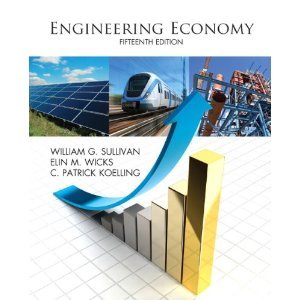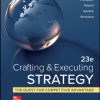Engineering Economy Sullivan Wicks Koelling 15th Edition Test Bank
$35.00 Original price was: $35.00.$26.50Current price is: $26.50.
Engineering Economy Sullivan Wicks Koelling 15th Edition Test Bank
Instant download Engineering Economy Sullivan Wicks Koelling 15th Edition Test Bank pdf docx epub after payment.

Product details:
- ISBN-10 : 0132554909
- ISBN-13 : 978-0132554909
- Author: William G. Sullivan Elin M. Wicks C. Patrick Koelling
Engineering Economy, 15e, is ideal for undergraduate, introductory courses in Engineering Economics. It also is a useful reference for engineers interested in reviewing the basic principles of engineering economy.
Used by engineering students worldwide, this best-selling text provides a sound understanding of the principles, basic concepts, and methodology of engineering economy. Built upon the rich and time-tested teaching materials of earlier editions, it is extensively revised and updated to reflect current trends and issues, with an emphasis on the economics of engineering design throughout. It provides one of the most complete and up-to-date studies of this vitally important field.
Table of contents:
CHAPTER 1 Introduction to Engineering Economy
1.1 Introduction
1.2 The Principles of Engineering Economy
1.3 Engineering Economy and the Design Process
1.4 Using Spreadsheets in Engineering Economic Analysis
1.5 Try Your Skills
1.6 Summary
CHAPTER 2 Cost Concepts and Design Economics
2.1 Cost Terminology
2.2 The General Economic Environment
2.3 Cost-Driven Design Optimization
2.4 Present Economy Studies
2.5 Case Study–The Economics of Daytime Running Lights
2.6 Try Your Skills
2.7 Summary
Appendix 2-A Accounting Fundamentals
CHAPTER 3 Cost-Estimation Techniques
3.1 Introduction
3.2 An Integrated Approach
3.3 Selected Estimating Techniques (Models)
3.4 Parametric Cost Estimating
3.5 Case Study–Demanufacturing of Computers
3.6 Electronic Spreadsheet Modeling: Learning Curve
3.7 Try Your Skills
3.8 Summary
CHAPTER 4 The Time Value of Money
4.1 Introduction
4.2 Simple Interest
4.3 Compound Interest
4.4 The Concept of Equivalence
4.5 Notation and Cash-Flow Diagrams and Tables
4.6 Relating Present and Future Equivalent Values
4.7 Relating a Uniform Series (Annuity) to Its Present and Future Equivalent
4.8 Summary of Interest Formulas and Relationships for Discrete Compounding
4.9 Deferred Annuities (Uniform Series)
4.10 Equivalence Calculations Involving Multiple Interest Formulas
4.11 Uniform (Arithmetic) Gradient of Cash Flows
4.12 Geometric Sequences of Cash Flows
4.13 Interest Rates that Vary with Time
4.14 Nominal and Effective Interest Rates
4.15 Compounding More Often than Once per Year
4.16 Interest Formulas for Continuous Compounding and Discrete Cash Flows
4.17 Case Study–Understanding Economic “Equivalence”
4.18 Try Your Skills
4.19 Summary
CHAPTER 5 Evaluating a Single Project
5.1 Introduction
5.2 Determining the Minimum Attractive Rate of Return (MARR)
5.3 The PresentWorth Method
5.4 The Future Worth Method
5.5 The Annual Worth Method
5.6 The Internal Rate of Return Method
5.7 The External Rate of Return Method
5.8 The Payback (Payout) Period Method
5.9 Case Study–A Proposed Capital Investment to Improve Process Yield
5.10 Electronic Spreadsheet Modeling: Payback Period Method
5.11 Try Your Skills
5.12 Summary
Appendix 5-A The Multiple Rate of Return Problem with the IRR Method
CHAPTER 6 Comparison and Selection among Alternatives
6.1 Introduction
6.2 Basic Concepts for Comparing Alternatives
6.3 The Study (Analysis) Period
6.4 Useful Lives Are Equal to the Study Period
6.5 Useful Lives Are Unequal among the Alternatives
6.6 Personal Finances
6.7 Case Study–Ned and Larry’s Ice Cream Company
6.8 Postevaluation of Results
6.9 Project Postevaluation Spreadsheet Approach
6.10 Try Your Skills
6.11 Summary
CHAPTER 7 Depreciation and Income Taxes
7.1 Introduction
7.2 Depreciation Concepts and Terminology
7.3 The Classical (Historical) Depreciation Methods
7.4 The Modified Accelerated Cost Recovery System
7.5 A Comprehensive Depreciation Example
7.6 Introduction to Income Taxes
7.7 The Effective (Marginal) Corporate Income Tax Rate
7.8 Gain (Loss) on the Disposal of an Asset
7.9 General Procedure for Making After-Tax Economic Analyses
7.10 Illustration of Computations of ATCFs
7.11 Economic Value Added
7.12 Try Your Skills
7.13 Summary
CHAPTER 8 Price Changes and Exchange Rates
8.1 Introduction
8.2 Terminology and Basic Concepts
8.3 Fixed and Responsive Annuities
8.4 Differential Price Changes
8.5 Spreadsheet Application
8.6 Foreign Exchange Rates and Purchasing Power Concepts
8.7 Case Study–Selecting Electric Motors to Power an Assembly Line
8.8 Try Your Skills
8.9 Summary 394of Single Cash Flows
CHAPTER 9 Replacement Analysis
9.1 Introduction
9.2 Reasons for Replacement Analysis
9.3 Factors that Must Be Considered in Replacement Studies
9.4 Typical Replacement Problems
9.5 Determining the Economic Life of a New Asset (Challenger)
9.6 Determining the Economic Life of a Defender
9.7 Comparisons in Which the Defender’s Useful Life Differs from that of the Challenger
9.8 Retirement without Replacement (Abandonment)
9.9 After-Tax Replacement Studies
9.10 Case Study–Replacement of a Hospital’s Emergency Electrical Supply System
9.11 Summary
CHAPTER 10 Evaluating Projects with the Benefit−Cost Ratio Method
10.1 Introduction
10.2 Perspective and Terminology for Analyzing Public Projects
10.3 Self-Liquidating Projects
10.4 Multiple-Purpose Projects
10.5 Difficulties in Evaluating Public-Sector Projects
10.6 What Interest Rate Should Be Used for Public Projects?
10.7 The Benefit−Cost Ratio Method
10.8 Evaluating Independent Projects by B−C Ratios
10.9 Comparison of Mutually Exclusive Projects by B−C Ratios
10.10 Case Study–Improving a Railroad Crossing
10.11 Summary
CHAPTER 11 Breakeven and Sensitivity Analysis
11.1 Introduction
11.2 Breakeven Analysis
11.3 Sensitivity Analysis
11.4 Multiple Factor Sensitivity Analysis
11.5 Summary
CHAPTER 12 Probabilistic Risk Analysis
12.1 Introduction
12.2 Sources of Uncertainty
12.3 The Distribution of Random Variables
12.4 Evaluation of Projects with Discrete Random Variables
12.5 Evaluation of Projects with Continuous Random Variables
12.6 Evaluation of Risk and Uncertainty by Monte Carlo Simulation
12.7 Performing Monte Carlo Simulation with a Computer
12.8 Decision Trees
12.9 Real Options Analysis
12.10 Summary
CHAPTER 13 The Capital Budgeting Process
13.1 Introduction
13.2 Debt Capital
13.3 Equity Capital
13.4 TheWeighted Average Cost of Capital (WACC)
13.5 Project Selection
13.6 Postmortem Review
13.7 Budgeting of Capital Investments and Management Perspective
13.8 Leasing Decisions
13.9 Capital Allocation
13.10 Summary
CHAPTER 14 Decision Making Considering Multiattributes
14.1 Introduction
14.2 Examples of Multiattribute Decisions
14.3 Choice of Attributes
14.4 Selection of a Measurement Scale
14.5 Dimensionality of the Problem
14.6 Noncompensatory Models
14.7 Compensatory Models
14.8 Summary
Appendix A Using Excel to Solve Engineering Economy Problems
Appendix B Abbreviations and Notation
Appendix C Interest and Annuity Tables for Discrete Compounding
Appendix D Interest and Annuity Tables for Continuous Compounding
Appendix E Standard Normal Distribution
Appendix F Selected References
Appendix G Solutions to Try Your Skills
Appendix H Answers to Selected Problems
Index 664
People also search:
Engineering Economy 15th Edition
Engineering Economy 15th Edition pdf
Engineering Economy
economic engineering in agriculture and rural development
engineering economics examples
Related products
Test Bank
Test Bank for Essentials of Business Law and the Legal Environment, 11th Edition: Richard A. Mann
Test Bank
Test Bank for Clinical Immunology and Serology A Laboratory Perspective, 3rd Edition: Stevens











